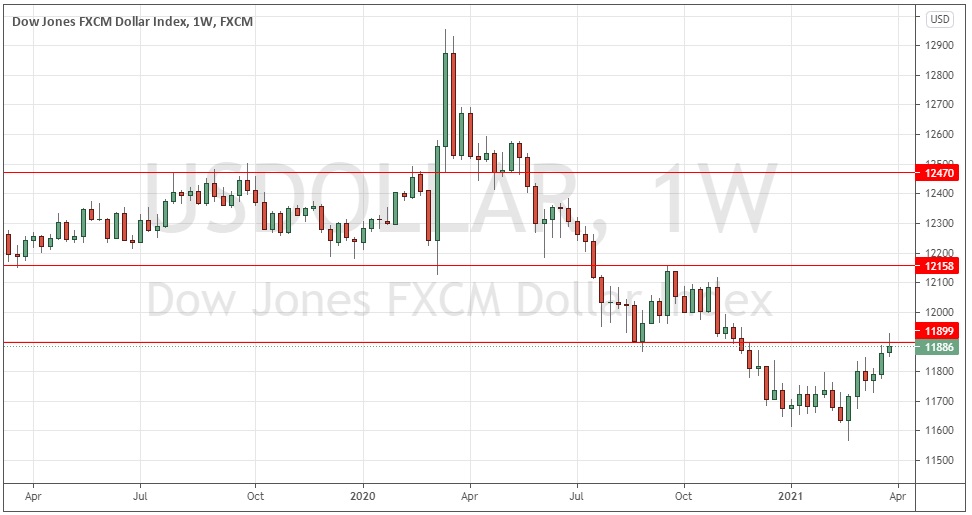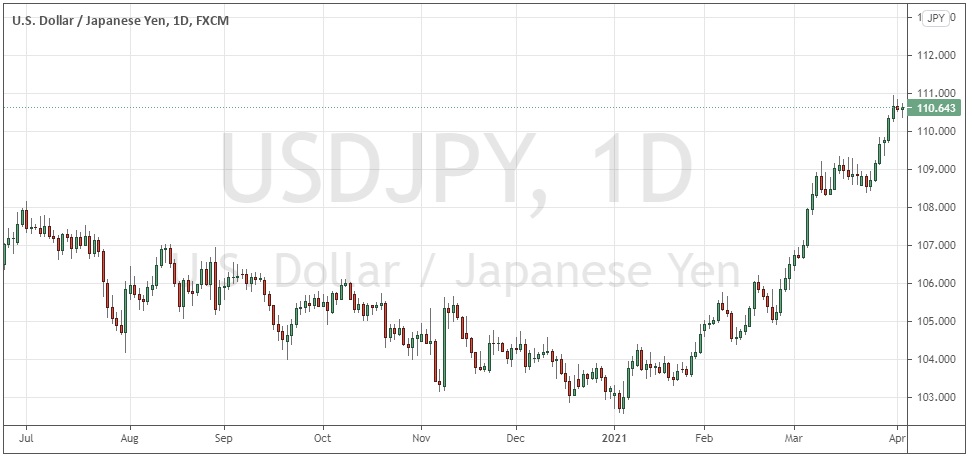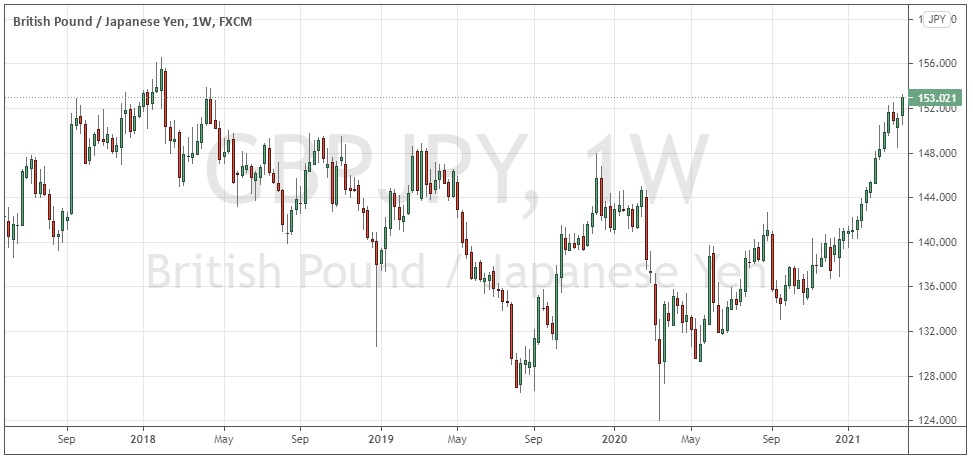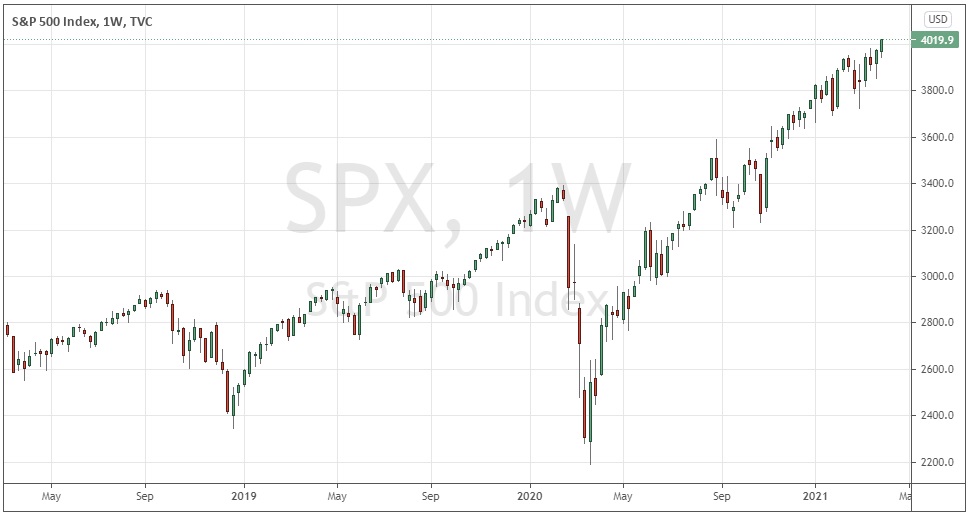The difference between success and failure in Forex trading is very likely to depend mostly upon which currency pairs you choose to trade each week and in which direction, and not on the exact trading methods you might use to determine trade entries and exits.
When starting the trading week, it is a good idea to look at the big picture of what is developing in the market as a whole and how such developments and affected by macro fundamentals and market sentiment.
It is a good time to be trading markets right now, as there are a few valid long-term trends left in favor of the U.S. dollar and the British pound against the Japanese yen and the euro, the U.S. stock market is also strong with the S&P 500 Index ending last week at a new all-time high price.
Big Picture 4th April 2021
Last week’s Forex market saw the strongest rise in the relative value of the New Zealand dollar and the strongest fall in the relative value of the Japanese yen. However, the real action in the Forex market is currently driven by the strong U.S. dollar.
I wrote in my previous piece two weeks ago that the best trade was likely to be being long of USD/JPY following a daily close above 109.23. We did not get a daily close above 109.23 until the last day of that week so it did not trigger a trade that week, but it was a good call as over the following week the USD/JPY currency pair rose by 0.84%.
Fundamental Analysis & Market Sentiment
The headline takeaway from last week is that the market sentiment is risk-on. Demand has been stoked by dovish monetary policy plus stimulus in the U.S., despite fears that policy will lead to untenable inflationary pressures. The week ended with the major U.S. stock index, the S&P 500, closing at an all-time high price of 4019.87 – the first daily close above 4000. European stock markets also hit record highs, with the DAX Index closing above 15,000. Global stock markets were generally higher over the week.
The U.S. dollar rose slightly over the past week as 10-year treasury yields edged up to a new long-term high but was having trouble following through on the move as the US Dollar Index bumped into technical resistance present at about 11900. There was little crucial economic data released last week except U.S. non-farm payrolls data, which came in far stronger than had been expected as the U.S. economy added almost one million jobs over the month. Despite this indication of a booming U.S. economy, the dollar was not much higher which indicates that the current dollar run may well not have much left in it. However, Friday’s trading may have been affected by the fact that a long weekend of public holidays had already begun in most nations in Europe and North America.
This coming week will see the release of FOMC Meeting Minutes concerning U.S. monetary policy as well as the RBA’s rate statement and Canadian employment data.
The Eurozone continues facing the problem of a resurgent coronavirus due to its very slow vaccination program. Italy, Poland, France, and some other nations have reimposed lockdown restrictions, which is bound to have a chilling effect on Eurozone economic growth. Nevertheless, many European stock markets are powering up to new highs. This suggests that a weakening euro may be caused more by the ECB’s quicker pace of bond purchases and less by the economic impact of the coronavirus – after all, Eurozone GDP is currently growing more quickly than it is in the U.S.
Last week saw the global number of confirmed new coronavirus cases rise for the fifth consecutive week after falling for over two months, driven mainly by a resurgence of the virus in Europe and Brazil. The total number of global deaths also rose again last week for the second week running.
Many countries have begun vaccination programs. Excepting extremely small nations, the fastest progress towards herd immunity has taken place in Israel which has fully vaccinated 53% of its population, followed by the U.A.E. at 22%. Immunization is proceeding relatively quickly in the U.S. and the U.K. but is going slowly in the European Union, where only a single member state has secured more than 8% of its population (Hungary).
The strongest growth in new confirmed coronavirus cases is happening in Andorra, Argentina, Austria, Azerbaijan, Bahamas, Bahrain, Bangladesh, Bosnia, Cameroon, Canada, Cuba, Chile, Colombia, Croatia, Cyprus, Djibouti, Egypt, Ethiopia, Greece, Iran, Iraq, Japan, Kazakhstan, South Korea, Lithuania, Luxembourg, Mali, Mauritius, Netherlands, North Macedonia, Oman, Philippines, Poland, Qatar, Serbia, Somalia, Slovenia, Switzerland, Tunisia, Turkey, Ukraine, U.A.E., the U.S., and Uruguay.
Technical Analysis
U.S. Dollar Index
The weekly price chart below shows the U.S. Dollar index printed a weakly bullish small near-pin candlestick last week which followed a more bullish candlestick from the week before. The consolidation of the past few weeks appears to have ended, with the dollar showing some bullish momentum, but the momentum is fading as it runs into ambiguous resistance which seems to be centered around 11900. The index is above its price from three months ago which is a bullish sign but is still below the key resistance level mentioned as well as sitting below its price from six months ago, suggesting that the upwards movement may be capped over the near term. Overall, next week’s price movement in the U.S. dollar looks somewhat likely to be bullish but upside may be limited. For this reason, it will probably be wise to wait for the Index to be established above 11900 before taking any long USD trades over the coming week.

USD/JPY
This major currency pair is clearly within a long-term bullish trend just from the strong momentum seen over the past few weeks. The price rose again last week with healthily above-average volatility. The Japanese yen is weak but the problem for bulls is that the U.S. dollar may find it hard to rise as its index is hitting key resistance. However, a daily close this week here above 110.75 on above-average volatility might well indicate that the price will rise considerably higher over the rest of the week.

GBP/JPY
The British pound has shown more relative strength recently than any other major currency except the U.S. dollar. It has reached a near 2-year high against the Japanese yen in the GBP/JPY currency cross, rising with healthy momentum last week. As the USD’s upside may be capped over the short-term, trading this cross long may be a profitable approach over the coming week. The pound has been boosted by recent revisions to U.K. economic data showing that the British economy has been growing more quickly than had been expected.

S&P 500 Index
The incredible rise of the U.S. stock market since the initial impact of the coronavirus in March 2020 continues, with the price powering up last week to close right on an all-time high. An additional bullish factor is that the closing price was above the big round number and psychological level at 4000. The price is in blue sky with bullish momentum, and the volatility is healthy enough to suggest the rise is likely to continue for some days.

Bottom Line
I see the best likely opportunities in the financial markets this week as being long of the S&P 500 Index and the GBP/JPY currency cross. There may be a good long trade in the USD/JPY currency pair following a daily close above 110.75 on above-average volatility.
